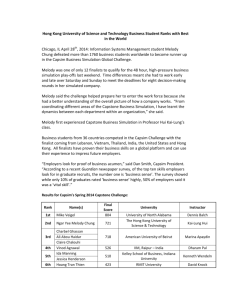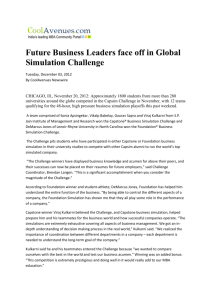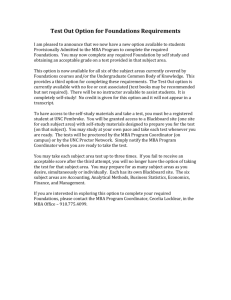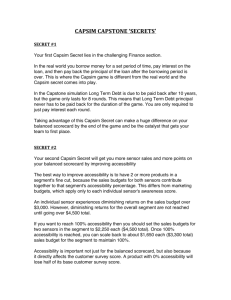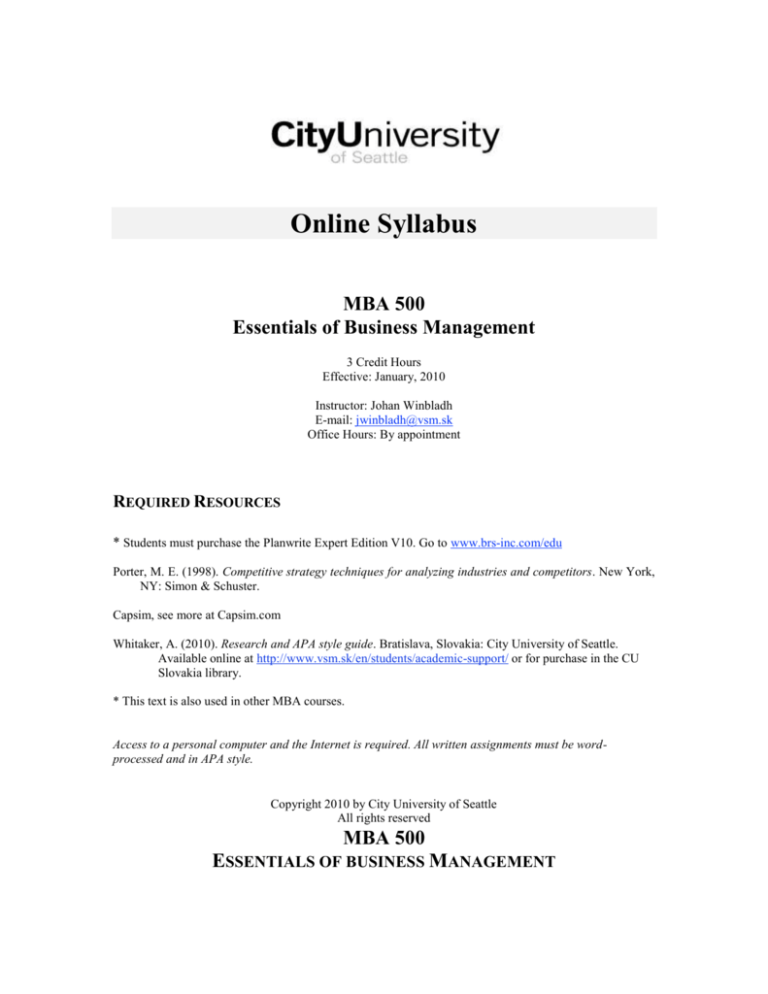
Online Syllabus
MBA 500
Essentials of Business Management
3 Credit Hours
Effective: January, 2010
Instructor: Johan Winbladh
E-mail: jwinbladh@vsm.sk
Office Hours: By appointment
REQUIRED RESOURCES
* Students must purchase the Planwrite Expert Edition V10. Go to www.brs-inc.com/edu
Porter, M. E. (1998). Competitive strategy techniques for analyzing industries and competitors. New York,
NY: Simon & Schuster.
Capsim, see more at Capsim.com
Whitaker, A. (2010). Research and APA style guide. Bratislava, Slovakia: City University of Seattle.
Available online at http://www.vsm.sk/en/students/academic-support/ or for purchase in the CU
Slovakia library.
* This text is also used in other MBA courses.
Access to a personal computer and the Internet is required. All written assignments must be wordprocessed and in APA style.
Copyright 2010 by City University of Seattle
All rights reserved
MBA 500
ESSENTIALS OF BUSINESS MANAGEMENT
This document provides an overview of the course foundation elements and assignments. For information
about general City University of Seattle policies, please see the City University of Seattle catalog. If you
have additional questions about the course, please contact your instructor.
Attendance Requirement
Students must take part in all online class activities. Failure to take part for 25% of the classes (Online
Assignments) will result in being dropped from the class. (Loss of eventual complete Financial Aid will
result.)
Late assignments policy
No late papers will be accepted.
Notification to Students with Disabilities
If you are a student with a disability and you require certain help, please contact the program manager or
your instructor as soon as possible.
SCHOLASTIC HONESTY POLICY
City University of Seattle expects each student to do his/her own work. The University has "zero
tolerance" for cheating, plagiarism, unauthorized collaboration on assignments and papers, using "notes"
during exams, submitting someone else's work as one's own, submitting work previously submitted for
another course, or facilitating acts of academic dishonesty by others. Scholastic Honesty policy applies
also to online discussions that represent a part of assignments in online courses. You should cite all the
information. Every reference material used in discussion contributions must be cited according to the
current Research & APA Style Guide. The penalties are severe! A first offense results in a zero grade for
the course and suspension for one quarter; a second offence can result in a zero grade for the course and
suspension for two or more quarters; a third offence can result in expulsion from the University. The
Policy and Procedures may be found http://www.vsm.sk/en/students/scholastic-honesty/policies-andprocedures/ .
In addition to providing your work to the instructor for grading, you must also submit an electronic copy
for the City University of Seattle archives (unless the work is specifically exempted by the instructor). You
will not receive a grade for particular work until and unless you submit this electronic copy. The procedure
for submitting work to the archives is to upload it via the website http://www.vsm.sk/en/students/on-linecenter/uploader/uploader.html . Files should include the cover page of the work with the student name,
instructor name, course name and number, and date. File names should indicate the type of assignment,
such as “researchpaper.doc”, “casestudy.doc” or “ thesis.doc” (student name should not be a part of the file
name because the system adds it). All files received into the archives are submitted to www.TurnItIn.com
for plagiarism checking.
COURSE DESCRIPTION
Successful managers need to understand the fundamentals of business practices within a global context.
This course will introduce you to the overall MBA program and prepare you for writing a comprehensive
and viable business plan. You will also practice business decision–making through the use of simulations.
Learning how to find relevant data through the use of credible sources will be a main focus of this course,
as well as how to effectively communicate in writing.
PROGRAM CONTEXT
This course begins the MBA program. It will lay the groundwork for subsequent MBA courses. Many of
the assignments completed in this course will be revisited as the program progresses. This course
contributes to the following end-of-program outcomes:
Communicate effectively both orally and in writing with internal and external stakeholders;
MBA 500
SYL
Page 2
Eff: 01/2010
Leverage managerial effectiveness through recognition of individual strengths, values and business
philosophy;
Capitalize on business opportunities in a rapidly changing environment by thinking critically and
applying quantitative procedures and tools;
Build, lead and participate in productive and diverse teams.
Throughout the MBA program, you will be expected to maintain an electronic portfolio of all major
assignments from each course, either in a folder or removable disk drive dedicated solely to this purpose.
Be sure to keep back up copies of all your portfolio components. The E-portfolio will enable you to reflect
back on your previous work. It will also become a valuable tool for you to use in presenting your work to
potential employers to demonstrate how you applied your leadership skills and abilities to devise strategies,
accomplish goals, and work in team environments.
COURSE OUTCOMES
After completing this course, you will be able to:
Demonstrate effective team participation;
After completing the disposition assessment, analyze personal business strengths and weaknesses,
and team function;
Given participation in a business simulation, articulate gaps in business knowledge, MBA
program goals and professional goals;
Implement business strategy;
Document strategic decision-making;
Using effective research strategies, research business ideas;
Draft an initial business proposal.
COURSE CONTENT
The course will cover the following concepts and topics:
Information literacy;
Team functioning;
Jungian types;
Self-analysis;
Performance criteria;
Company structure and functions;
Documentation methods;
Components of a business proposal.
RECOMMENDED RESOURCES
As a City University of Seattle student, you have access to library resources regardless of where and
how you are taking this class. To access the resources that are necessary to complete your coursework and
assignments, visit the library menu in the My.CityU portal.
A good place to begin your research is through the program or course resource sections that provide links
to relevant journals, books, and Web sites. Search the library's online catalog to locate books and videos,
and place requests to have items mailed to you (services vary by location). Search the online databases for
journal, magazine, and newspaper articles. Articles that are not available full text in the library's collection
can be requested from other libraries and delivered to you electronically.
MBA 500
SYL
Page 3
Eff: 01/2010
OVERVIEW OF COURSE ACTIVITIES AND GRADING
Grade % See schedule for details
Assignments
Individual – 70%
Capsim Introductory Lessons and Rehearsal Simulation Rounds (at least four
rounds), and Situation Analysis (as an individual)
Porter’s Company Competitive Analysis
5%
20%
Business Plan (Idea) Proposal with business-viability justification supported with
research
Final Personal Learning Journal (PLJ) including Professional Assessment &
Development Plan (PADP). Individual entries need to be completed as scheduled for
Sessions 3 to 10. Individual session entries are not submitted for grading. The final
PLJ (with all scheduled session entries and PADP) is submitted for grading in
Session 10.
Team – 30%
Team assignment grades for individual team members will be the same as earned by
the team if the individual contributed equitably to helping the team complete the
team assignment. The instructor reserves the right to lower grades for individual
team members that do not contribute equitably to helping the team coordinate and
complete team assignments.
Team Situation Analysis & Strategy Report
15%
Capsim Competition Rounds 1 & 2 - Team company performance in two
competition rounds of Capstone Business Simulation
Final Team Decision-Making Journal (TDMJ). Entries need to be completed as
scheduled for Sessions 5 to 10. Individual session entries are not submitted for
grading. The final Team Decision-Making Journal with all scheduled session entries
is submitted for grading in Session 10.
5%
Team Peer Evaluation
30%
5%
15%
5%
Total
100%
While the instructor will provide detailed instructions on assignments, general guidelines are below.
Business simulation #1
- Participate in a team-oriented business simulation, analyze results, reflect and determine learning needs.
-Write an analysis of the business results of the simulation.
-Reflect on how personality styles, within the team, contributed to the simulation results.
Professional Development Plan
-Write a professional development plan that includes learning needs during the MBA program.
Business Plan Proposal
-The introduction of the BRS Business Writing Software Program to MBA 500 students and a discussion of
how it works, with an explanation of its role in MBA 500, and its role throughout the MBA Program.
-Familiarize MBA 500 students to the BRS Business Writing Software Program, covering topics related to
the Oveview, and to the Resources, located in the BRS Business Writing Software Program.
-Discuss that the development of the initial proposal for the business plan in MBA 500 will used in concert
with the BRS Business Writing Software Program, and that the BRS Business Writing Software Program
will be used throughout the MBA Program for the business plan.
-Students must prepare an initial proposal for a business plan in MBA 500 using the BRS Business Writing
Software Program.
MBA 500
SYL
Page 4
Eff: 01/2010
Please note that MBA 500 students must purchase the BRS Business Writing Software Program directly
from BRS without exception. In addition, students experiencing technical difficulties with their BRS
Business Writing Software Program must report this directly to the BRS Customer Service Staff at (512)
251-7541, or e-mail at support@brs-inc.com, and not their instructor for the MBA 500 course.
ASSIGNMENTS AND GRADING CRITERIA
BUSINESS PLAN PROPOSAL ASSIGNMENT:
One of the final deliverables for the MBA program is a comprehensive business plan. In the MBA500
course, you will select the business concept (idea) for the business plan and provide supporting justification
for the proposed business.
The Business Plan Proposal will cover the business vision and intended mission, description of
products/services, target market and proposed competitive strategy for the business plan you will develop
during the MBA program. The business planning textbook (Abrams) provides information on the content of
a business plan proposal.
Selecting a Topic/Company for the Business Plan Proposal
Select a business concept (idea) with products/services for which you have a passion. The research,
analysis, developing and writing of a comprehensive business plan require immense effort and time. It is
important that you select a business concept (idea) that is of interest to you, as well as realistic. Select a
business concept that you will enjoy learning, researching and analyzing for a potential business.
It is recommended that the business plan be for a new/start-up business or a new product or service for an
existing company. It is critically important that you have access to information, data and statistics required
to develop the comprehensive business plan. The business plan can be for a for-profit or non-profit
business. The business concept/idea must be realistic. The business concept must be one that can be
developed into comprehensive business plan for a viable business that can attract or be approved for
funding and implemented.
Additional information for developing and writing the business plan proposal is available in within the BRS
PlanWrite Software package.
Grading Criteria for the Business Plan Proposal
Business concept and justification, clarity and realistic
20%
Vision and mission, viable and realistic
10%
Target market, clearly defined and appropriate
10%
Concept analysis, realistic and specific
10%
Competitive strategy, viable, realistic and appropriate
20%
Evidence of critical reflection
10%
Presentation (organization, format, citations)
10%
Writing (appropriateness of language, style, punctuation and grammar)
10%
Total
100%
MBA 500
SYL
Page 5
Eff: 01/2010
PERSONAL LEARNING JOURNAL (WITH PROFESSIONAL ASSESSMENT AND DEVELOPMENT
PLAN (PADP) SECTION):
The MBA Program requires participants to be an active partner in achieving personal and professional
learning and self-development goals. Active involvement and commitment to continuous learning and selfdevelopment simulate the activities of successful business managers and leaders in the competitive global
environment.
The Personal Learning Journal, which includes the Professional Assessment and Development Plan,
comprises 30% of the MBA500 class grade. Entries for the Personal Learning Journal need to be completed
for Sessions 3 to 10. The PADP section needs to be finalized and included in the final Personal Learning
Journal.
PROFESSIONAL ASSESSMENT & DEVELOPMENT PLAN (PADP) – SECTION OF PERSONAL LEARNING
JOURNAL
The purpose of the Professional Assessment & Development Plan is to assess and integrate what you have
read, written and experienced during the course into a personal development plan for the future. Identify
career objectives for the short and medium term, and assess personal and professional strengths and
weaknesses relative to career aspirations in your PADP.
The personal development plan completed for this course will be one that you will work on throughout the
MBA Program.
The goals of this assignment are:
1.
Assess and integrate what you have learned in this course into personal development plan for the
future.
2.
Assess and document your professional goals. It is recognized that your professional goals may
not be known exactly and may change later. Nevertheless, for your PADP for this course, share
specific professional goals, including positions and roles. As stated earlier, the resulting
professional development plan will be one that you will work on throughout the MBA Program.
3.
Assess and document specific opportunities and challenges associated with your specific
professional goals, positions and roles. Reference what you have learned in this course in general
and specific course materials.
4.
Assess and document how you will develop required knowledge and comprehension, skills and
capabilities to leverage identified opportunities and effectively address identified challenges.
Reference what you have learned in this course in general and specific course materials. It is
recognized that your identified professional goals are volatile – in flux and subject to change.
Nevertheless, be specific about you believe you will need to know and understand, and the skills
and capabilities that you need to develop and/or acquire.
Grading Criteria for Personal Learning Journal (including Professional Assessment and
Development Plan)
Completeness – Entries for Sessions 3 to 10 address all assigned aspects
10%
Personality type – assessment of impact on approach to MBA Program,
professional goals & career
10%
Strengths and Weaknesses in Business Knowledge & Lessons Learned
35%
Professional Assessment and Development Plan
15%
Evidence of critical reflection
10%
Presentation (organization, format, citations)
10%
Writing (appropriateness of language, style, punctuation and grammar)
10%
MBA 500
SYL
Page 6
Eff: 01/2010
Total
100%
TEAM DECISION-MAKING JOURNAL (ENTRIES & FINAL JOURNAL):
MBA 500 requires that participants work on teams. These teams simulate the challenges faced by real life
executive leadership teams in defining problems and making decisions. Effective team performance is vital
to business success and bottom line results.
Team assignments and activities comprise 30% of the class grade. The Team Decision-Making Journal
comprises 15% of the class grade. This journal documents the team’s decision-making process and includes
decision and the rationale (why) for actual decisions made by the team for Capsim Competition Rounds.
The Team Decision-Making Journal will be shared with future teams assigned to the Capsim Company in
subsequent MBA Program classes. The team needs to collect and compile individual team perspectives for
Team Decision-Making Journal entries. Entries for the Team Decision-Making Journal need to be
completed for Sessions 6 to 10. Team Decision-Making entries for Sessions 6 to 10 are integrated into the
final Team Decision-Making Journal due in Week 10.
Grading Criteria for Team Decision-Making Journal
Completeness – Entries for Sessions 5 to 10 address all assigned aspects
10%
Familiarity with business strategy concepts in Corporate Strategy text
10%
Decisions and rationale for Capsim Competition Rounds 1 & 2
25%
Evaluation/Analysis of results & how to improve performance/decisions made for
Capsim Competition Rounds 1 & 2. Recommendations and thoughts for subsequent
Capsim Competition Rounds (Round 3 and higher.)
25%
Evidence of critical reflection
10%
Presentation (organization, format, citations)
10%
Writing (appropriateness of language, style, punctuation and grammar)
10%
Total
100%
PORTER – COMPANY COMPETITIVE ANALYSIS ASSIGNMENT:
The fundamental assumption of this assignment is that the profit potential of any firm is a function of: (1)
the industries it operates in; and (2) the competitors it opposes. Therefore to enhance profits, executive
management must understand the industry structure and competition. The profits within an industry are
affected by a wide range of influences, including the macroeconomic environment, cost and demand
structures of the industry, technological change and government regulation. Competitive moves and
responses of incumbents also affect firm profits. Actions taken by firms to improve competitive position
engender responses by other firms, and the expected sequence of actions and responses must be understood
to develop an effective strategy. Reactions of rivals will depend on their goals or intent, beliefs, relative
resource positions and past actions. Thus, the approach to studying the dynamics of industry structure and
competitors is to focus on the key characteristics of industry structure and the individual competitive moves
and countermoves by the competitive players.
Using the components of a competitive analysis Figure 3-1 in the Porter’s text book (page 49), students
select a primary company in an industry that they have interest and/or are familiar. Students analyze and
contrast the competitive strategy of primary company and the other two competitors’ strategy. Students
MBA 500
SYL
Page 7
Eff: 01/2010
then develop a competitive profile for the primary company and the two other companies in the industry
using the Porter competitor analysis criteria
Next, analyze and contrast the competitive strategy of the primary company with the other 2 competitors’
strategy then answer the following questions:
1.
What is the primary company’s current competitive strategy (be specific)?
2.
What are the two competitors doing to improve their current competitive position?
3.
What likely moves or strategy shifts will the two competitors make?
4.
Where is the primary company most vulnerable?
5.
Where are the two competitors most vulnerable?
6.
What competitive moves by the two competitors will provoke the greatest and most effective
retaliation by the primary company?
7.
Would you recommend the continuation or modification of the primary company’s current
strategy (support your rationale with specifics)?
Porter competitor analysis criteria
Estimated overall business strength
Market share (percent, rank)
Market share trend (five years)
Financial strengths
Profitability
Management
Technology position
Other key strengths/limitations (e.g., production cost advantages)
Marketing strategy (assessment of key strengths and limitations)
Competitive strategy (Porter’s)
Market strategy
Distribution strategy
Recent offensive or defensive competitive moves
Grading Criteria for Porter’s Competitive Analysis
MBA 500
SYL
Page 8
Eff: 01/2010
Clarity of expression
15%
Integration of course concepts, where relevant
20%
Completeness of analysis
30%
Logically supported conclusions and recommendations (including
proper APA references support if applicable)
Grammar, spelling, punctuation, and syntax
25%
TOTAL
100%
10%
TEAM PEER EVALUTION:
MBA 500 requires working on teams. These teams simulate the challenges faced by real-life executive
management teams in defining and resolving business problems and making strategic-level decisions.
Effective team performance is linked to business success and bottom-line results.
This Team Peer Evaluation of team performance and contributions of yourself and other team members
comprises 5% of the class grade.
Complete a Team Peer Evaluation individually after all team assignments have been completed and submit
in Week 10.
The evaluation form is in appendix 1 in this syllabus.
PROFESSIONAL PRESENTATION OF WRITTEN WORK
All assignments submitted for this course should be of professional quality. You should present
each paper in a format that would be appropriate for submitting to upper management.
References should be cited for all facts, ideas, conclusions, and opinions not your own. The
reference page and in-text references must follow APA format.
A proper title page should preface all written assignments. The title page should include your
name, the title of the paper, the name and number of the course, the start date of your course, the
date submitted and the name of the instructor.
Your work should be word-processed on white A4 paper. Pages should be numbered and
calculations as well as formulas shown to support answers where appropriate. Some assignments
may require that your work be prepared on a computer spreadsheet. Spreadsheet data can be put
in a table in word.
RECOMMENDED COURSE SCHEDULE
The schedule for course activities and assignments is below. If you find you are unable to
complete the assignments as scheduled, contact your instructor. Your instructor may elect to
adjust the outline to meet the unique needs of the class.
MBA 500
SYL
Page 9
Eff: 01/2010
SESSION
1
TOPICS AND ASSIGNMENTS
Introduce MBA Program, the MBA 500 Course and
2
READINGS
Porter, Chapter 1
review of MBA500 Assignments.
Read Capsim Student Guide
Register for Capsim at Capsim.com and become
and (Online) Manager’s
familiar with materials located on the “Getting
Guide at Capsim.com.
Started” page.
Overview the Strategic Management Process per the
Porter’s text book.
Porter’s The Structural Analysis of Industries.
Review the Team Handbook.
Establish team assignments, including the peer
evaluation and the team grading process.
Explanation of Capsim step-by-step and Q&A Team Handbook regarding Capsim to address questions and concerns Introduction, Chapters 1-3
about Capsim
Complete Capsim Introductory Lesson and score the Porter, Chapter 2
Introductory Lesson Quiz at Capsim.com.
Complete Rehearsal Simulation Rounds 1 – 4
(additional rounds are optional) at Capsim.com.
Complete Situation Analysis at Capsim.com.
Meet with team members to share contact
information, discuss and agree on roles and
responsibilities, and develop a plan and schedule for
completing team assignments.
DUE: Capsim Introductory Lessons & Quiz,
Rehearsal Simulation Rounds (at least four
rounds), and Situational Analysis (as an
individual).
3
Review the Business Planning Process.
Porter’s Generic Competitive Strategies.
Debrief: Capsim Simulation Rehearsal Rounds 1 - 4.
Determine Capsim company performance measures.
Set-up and start Personal Learning Journal (includes
Personal Assessment and Development Plan).
Complete Team Practice Round 1
Start discussing a team strategy guided by six
strategies discussed in The Manager’s Guide at
Capsim.com for team Capsim Company and
understanding of Porter’s Generic Competitive
Strategies.
DUE: Personal Learning Journal Entry (not handedin/graded)
MBA 500
SYL
Page 10
Eff: 01/2010
Porter, Chapter 3
Team Handbook, Chapters
4- 6.
The Manager Guide’s Six
Strategies at Capsim.com.
4
Porter - Framework for Competitor Analysis.
Complete
personality
profile
questionnaire
(Myers/Briggs type) online or in the classroom.
Porter, Chapter 4
Myers/Brigg type personality profile background and
overview. Provide a basis for understanding the Team Handbook, Chapters
profile assessment.
7-8.
Q&A decision making, personal traits, career
development, business success, teams, teamwork and Complete Personality Type
team leadership.
Questionnaire (Jung
Overview Capsim Practice Round 1 to be completed Typology Test – Jung
Myers-Brigg Typological
by teams.
Select a strategy for Capsim Company. Review and Approach).
discuss.
Start working on Team Situation Analysis and
Strategy Report.
Complete Team Practice Round 2
DUE: Personal Learning Journal Entry (not handedin/graded)
5
Porter’s - Market Signals.
Review the basic decision-making principles in
Porter, Chapter 5
Capsim.
Discuss and review Capsim Practice Round 2 results
and how to analyze results to prepare for Capsim
Competition Rounds.
Discuss
the
Professional
Assessment
and
Development Plan section of the Personal Learning
Journal
Selection of cohort leader by class – Done with
Cohort Advisor
Administer C.A.T. class evaluation
Complete Team Situation Analysis and Strategy
Report.
Determine performance measures for the team’s
Capsim Company.
Complete Capsim Team Practice Round 3.
Prepare for Capsim Competition Round 1 by
reviewing and analyzing Practice Round results.
Set-up and start Team Decision-Making Journal
DUE: Team Situational Analysis & Strategy
Report
DUE: Personal Learning Journal Entry (not handedin/graded)
DUE: Team Decision-Making Journal Entry(not handedin/graded)
MBA 500
SYL
Page 11
Eff: 01/2010
6
Porter’s - Competitive Moves.
Teams report on Capsim Team Situation Analysis and
Strategy Report Practice Round results to class.
Teams report on team performance and challenges.
Discuss criteria for choosing a viable business plan
idea.
Review and explore the BRS PlanWrite Software,
introduction, Sections 1, 2, and 3, and review sample
BRS PlanWrite Software
business plans
Begin drafting Professional Assessment and
Development Plan section for Personal Learning (Continued) Porter, Chapter
5
Journal
Begin researching Business Plan Proposal (Proposed
Business Concept/Idea and Justification) - The key
word for this assignment is “Proposal.” It is not a
complete business plan. The complete business plan
will be completed over the course your MBA
program. The proposal covers the business concept
with business-viability justification based on
research.
Complete Capsim Competition Round 1.
DUE: Porter’s Company Competitive Analysis
DUE: Personal Learning Journal Entry (not handedin/graded)
DUE: Team Decision-Making Journal Entry(not handedin/graded)
7
Porter’s short term/long term offensive and defensive
strategies.
Discuss how to explore, research, analyze and choose
viable business ideas.
Break-out into groups (not Capsim teams) to
brainstorm criteria for selecting viable business ideas. BRS PlanWrite Software
Discuss Capsim Competition Round 1 results.
Continue with the BRS PlanWrite Software, per
instructions of the instructor.
Continue research and working on Business Plan
Proposal.
Complete Capsim Competition Round 2.
DUE: Personal Learning Journal Entry(not handedin/graded)
DUE: Team Decision-Making Journal Entry(not handedin/graded)
MBA 500
SYL
Page 12
Eff: 01/2010
8
Open discussion about Capsim experiences to date.
Open discussion about the team building process,
group/team discussion making and the implication of
the Capsim and team experience for both personal
and professional development.
BRS PlanWrite Software
Allow time for teams to meet to finalize decisions for
Capsim Competition Round 3.
Finalize Business Plan Proposal for submittal in
Week 9.
Complete Capsim Competition Round 3.
DUE: Personal Learning Journal Entry(not handedin/graded)
DUE: Team Decision-Making Journal Entry(not handedin/graded)
9
Business
Plan Proposal and Business Plan
development from the BRS PlanWrite Software.
Discuss: Business Strategy Evaluation.
Review the sample Business Plan in the BRS
PlanWrite Software, and summarize the purpose of
each section of the business plan.
Recap that development and writing of a
comprehensive business plan happens throughout the
MBA program.
Teams present Capsim Competition Round 3 results,
decisions and reasoning, decision-making process and
BRS PlanWrite Software
team experience.
Complete and submit final Business Plan Proposal
with business-viability justification supported with Review Practicum
research. Research materials used in the proposal Handbook and Information
need to be cited and listed adhering to APA format.
Complete Capsim Competition Round 4.
DUE:
Business Plan (Idea) Proposal with
Business-Viability Justification Supported with
Research
DUE: Capsim Competition Rounds 1 & 2:
Team
Company
Performance
in
Two
Competition Rounds of Capstone Business
Simulation
DUE: Personal Learning Journal Entry(not handedin/graded)
DUE: Team Decision-Making Journal Entry(not handedin/graded)
MBA 500
SYL
Page 13
Eff: 01/2010
10
Final review of Capsim to assure that students are
comfortable with the process and terminology, as
well as the role of teams in performing the simulation
as executive management.
Final Team presentation as executive management
team to class (Board of Directors) regarding Capsim
No Readings for This
Company performance and recommendations for
Session
improvements in future competition rounds.
Final review of MBA program and the roles of
Personal Learning Journal (with Personal Assessment
and Development Plan), Team Decision-Making
Journal, Business Plan Proposal, Teams and Capsim
throughout the MBA Program.
Complete Team Peer Evaluation and turn in at the
end of class.
Complete and submit Final Personal Learning Journal
with all session entries (Sessions 3 to 10) made
during the class. Complete and include finalized
Professional Assessment and Development Plan
(PADP) in the final Personal Learning Journal. The
Final Personal Learning Journal with PADP needs to
be submitted as one Word document.
Complete and submit Final Team Decision-Making
Journal with all session entries (Session 5 to 10) made
during the class. Only one copy of the Final Team
Decision-Making Journal needs to be submitted by
the team. Select one team member to submit a copy
for the team. The Final Team Decision-Making
Journal needs to be submitted as one Word document.
Debrief and Review: Capsim Competition Round 4.
DUE: Final Personal Learning Journal,
Including Professional Assessment &
Development Plan
DUE: Final Team Decision-Making Journal
DUE: Team Peer Evaluation
MBA 500
SYL
Page 14
Eff: 01/2010
Appendix 1
Student Course Documents:
MBA500 Team Peer Evaluation
MBA 500
SYL
Page 15
Eff: 01/2010
Your Name:
Capsim Team Name:
Evaluate yourself and each of your team members based on a 5-point rating of the following ten
Team Contribution Criteria items. Enter your name in the first slot (Your Name) and names of
other team members in each subsequent slot (Team Member Name). Enter a rating of 1 to 5 for each
Team Contribution Criteria for each team member. After entering ratings for all team members,
calculate the total rating score for each team member. Enter the total rating score for each team
member after “Total Points.” The highest total rating score possible is 50.
Strongly DISAGREE
Disagree
1
2
Neutral Agree
3
4
Strongly AGREE
5
Team Peer Evaluation
Team Contribution Criteria
Your Name
Team Member Name
Team Member Name
Team Member Name
Team Member Name
Team Member Name
Team Member
Name
Took active role in initiating necessary team activities and helping coordinate team activities.
Effectively communicated with team. Communications were timely and constructive
Demonstrated respect for all team members, willing to negotiate and make compromises for the success of
the team.
Participated actively in meetings and/or discussions (in-person and/or online)
Contributed ideas, suggestions, information and resources that helped team complete team assignments and
accomplish goals
Volunteered and/or willing accepted responsibilities for work (tasks) determined by the team.
Work (tasks) completed for team was done well and met or exceeded requirements.
Work (tasks) was completed in a timely manner by agreed-to due dates
Demonstrated good leadership and follower-ship when appropriate and whenever necessary
Contributed to the overall success and performance of the team
Total Points (Total highest Possible Points is 50)
0
MBA 500
SYL
0
Page 16
0
0
Eff: 01/2010
0
0
0
APPENDIX 2
SAMPLE JOURNAL TEMPLATES AND BUSINESS PLAN PROPOSAL GUIDE
The following sample Journal Templates and Business Plan Proposal Guide/Template are “samples.”
Instructor will need to customize for the specific class.
PERSONAL LEARNING JOURNAL TEMPLATE – SAMPLE
Complete entries as scheduled. Individual entries
are not submitted for grading. The final Personal
Learning Journal with all entries is submitted for
grading in Week 10.
Personal Learning Journal (PLJ)
MBA500
Your Name:
This Personal Learning Journal (PLJ) Template is meant as a guide for entries.
The space for each section expands as additional content is entered. Make additional copies of specific
sections as needed for additional session entries.
Instructions
The assigned focus is the specific topic assigned for the session entry such as: Describe own strengths and
weaknesses in business knowledge. Reflections about own personality type, Lessons Learned for this
session, etc. If the assigned focus is “Lessons Learned for this session,” the “Answer – Thoughts about
Assigned Focus Topic” section may be combined with the Lessons Learned section. The Lessons Learned
section needs to be completed for all entries. In the Lessons Learned section, described what you
specifically learned (personal awareness, personal growth, professional development, business and
management knowledge and understanding, etc.) In Items for Further Action & Exploration section,
describe specific items that you believe require further action and/or exploration to clarify, answer
questions, address uncertainties, strengthen skills, and/or expand understanding.
The Personal Assessment and Development Plan (PADP) Template follows the PLJ Template. The PADP
needs to be completed for the Final Personal Learning Journal that is submitted for grading in Week 10.
Session #___ Entry
Assigned Focus for Personal Learning Journal Entry:
MBA 500
SYL
Page 17
Eff: 01/2010
Answer - Thoughts about Assigned Focus Topic:
Lessons Learned:
Items for Further Action & Exploration
Exploration, Action & Improvement Plan
Review the items listed for further action and exploration. For each item listed, describe the specific
research and/or practice required to clarify, answer questions, address uncertainties, strengthen skills,
and/or expand understanding. In the Improvement Plan section, describe the specific actions you plan to
take to improve your understanding, knowledge and skills for each item, and expected time frame for the
actions.
Further Research and Practice:
Improvement Plan:
MBA 500
SYL
Page 18
Eff: 01/2010
Appendix 3
Professional Assessment and Development Plan - Section of Personal Learning Journal
This Professional Assessment & Development Plan Template is meant as a guide.
The space for each section expands as additional content is entered.
Professional & Personal Assessment
Assessment - Reasons for Enrolling in the MBA Program:
Assessment - Professional Benefits of Completing the MBA Program:
Assessment - Current Qualifications, Knowledge and Skills:
Assessment – Target/Desired Qualifications, Knowledge and Skills:
Assessment - Personality Type & Professional Goals:
Comments:
MBA 500
SYL
Page 19
Eff: 01/2010
Assessment of Key Lessons-Learned
Assessment – Key Lessons-Learned from knowing and analyzing own personality type:
Assessment – Key Lessons-Learned from Capsim Rounds 1 and 2:
Assessment – Key Lessons-Learned about own strengths and weaknesses:
Professional Development Plan
Additional Priority Items can be added by copying a priority section and pasting at the end of the last
priority section (append to table). After appending an addition priority section to end of the table, change
the Priority # to the correct # (e.g., 6, 7, 8, etc.)
Priority 1 - Develop/Strengthen:
Action Time Frame:
Development Method/Approach:
Current Proficiency:
Target Proficiency:
Criteria for Measuring Success:
Comments:
MBA 500
SYL
Page 20
Eff: 01/2010
Priority 2 - Develop/Strengthen:
Action Time Frame:
Development Method/Approach:
Current Proficiency:
Target Proficiency:
Criteria for Measuring Success:
Comments:
MBA 500
SYL
Page 21
Eff: 01/2010
APPENDIX 4
TEAM DECISION-MAKING JOURNAL TEMPLATE – SAMPLE
Complete entries as scheduled. Individual entries
are not submitted for grading. One copy of the
Team Decision-Making Journal (TDMJ) Template final Team Decision-Making Journal with all
entries is submitted for grading in Week 10.
Team Name and Members:
MBA500
This Team Decision-Making Journal Template is meant as a guide for entries.
The space for each section expands as additional content is entered. Make additional copies of specific
sections as needed for additional session entries.
Session #___ Entry – Capsim Practice Round
Assigned Focus: Describe the decision-making process (how the team will make decisions), the decisions
made during the Capsim Practice Round and the reasoning – the why for the decisions. Discuss if the team
plans to use the same decision-making process for upcoming Capsim Competition Rounds as used during
the Practice Round.
Decision-Making Process
Decisions Made and Rationale (Why) for Capsim Practice Round
MBA 500
SYL
Page 22
Eff: 01/2010
Decisions Made by the Team – Business Strategy Decisions
Rationale (Why) for each Decision:
Decisions Made by the Team - Other Decisions Made During the Session:
Rationale (Why) for each Decision:
Discuss if the team plans to use the same decision-making process for upcoming Capsim Competition
Rounds as used during the Practice Round:
Comments:
MBA 500
SYL
Page 23
Eff: 01/2010
Session #__ Entry for Capsim Competition Round #____
Assigned Focus: Summary of the decision-making process, decisions and rationale for decisions for
Competition Round. Include evaluation/analysis of quality/effectiveness of decisions made in the
Competition Round. Evaluation/analysis of decisions should include analysis of Capsim reports for
Competition Round results such as financial statistics and Balanced Scorecard. Recommend including
copies of pertinent information and data for the Competition Round from Capsim reports in the journal.
Summary of decision-making process, decisions and rationale for business strategy decisions for the
Competition Round.
Evaluation/Analysis of Quality/Effectiveness of Decisions – Include analysis of Capsim Reports for
Competition Round One results. Include copies of pertinent information and data from Capsim
reports.
Evaluation/analysis of quality/effectiveness of decisions (performance level):
MBA 500
SYL
Page 24
Eff: 01/2010
Decisions Made by the Team - Other Decisions Made During the Session:
Rationale (Why) for each Decision:
Comments:
Session #___ Entry – Decision-Making Lessons Learned from Capsim Competition Rounds
Assigned Focus: Describe business decision-making lessons-learned from Capsim Competition Rounds 1
and 2. Describe decisions changes the team would make to improve performance results in Competition
Rounds One and Two and rationale
Complete and submit Final Team Decision-Making Journal with all session entries made during the class.
Only one copy of the Final Team Decision-Making Journal with all entries needs to be submitted by the
team. Select one team member to submit a copy for the team. The Final Team Decision-Making Journal
needs to be submitted as one Word document.
Business Decision Lessons Learned:
Decisions Changes Team Would Make to Improve Performance Results and Rationale
MBA 500
SYL
Page 25
Eff: 01/2010
Decisions Changes Team Would Make to Improve Performance Results in Competition Round
#____ and Rationale:
Decisions Changes Team Would Make to Improve Performance Results in Competition Round
#____ and Rationale:
Decisions Made by the Team - Other Decisions Made During the Session:
Rationale (Why) for each Decision:
Comments:
MBA 500
SYL
Page 26
Eff: 01/2010
Appendix 5
BUSINESS PLAN PROPOSAL AND JUSTIFICATION GUIDE – SAMPLE:
The Business Plan Proposal and Justification – Guide for Development
Part 1 – Business Concept (Idea) & Justification
Part 2 – Vision and Mission Statement
Part 3 – Define the Target Market
Part 1 – Business Concept (Idea) & Justification
Provide a detailed description of the business concept (idea). Justify the business concept (idea) - explain
why you believe the business concept (idea) is realistic and viable. Recommend completing the justification
after Parts 3 and Parts 4 have been completed, as market research information and data are required to
support business viability.
Part 2 – Vision and Mission Statement
Develop a vision and mission statement. The vision and mission statement provides the foundation for the
development of the business plan. This statement is a synopsis about the nature of the business.
Part 3 – Target Market Definition
Define the target market. Who are the customers that are going to be buying your products or using your
service and why will they buy your product or service? Clearly define your target market. Explain why
MBA 500
SYL
Page 27
Eff: 01/2010
your product or service is unique and how it will fulfill specific needs and/or occupy a special market
niche.
Assess industry structure and performance
Assess overall demographics to develop a consumer profile - (Answer who and what)
Define the target customer base in the proposed market area - (Answer how many)
Define the geographic market area to be developed - (Answer where and what competition)
Determine the target market area to determine market potential - (Answer what is the sales
potential and potential market share)
MBA 500
SYL
Page 28
Eff: 01/2010


